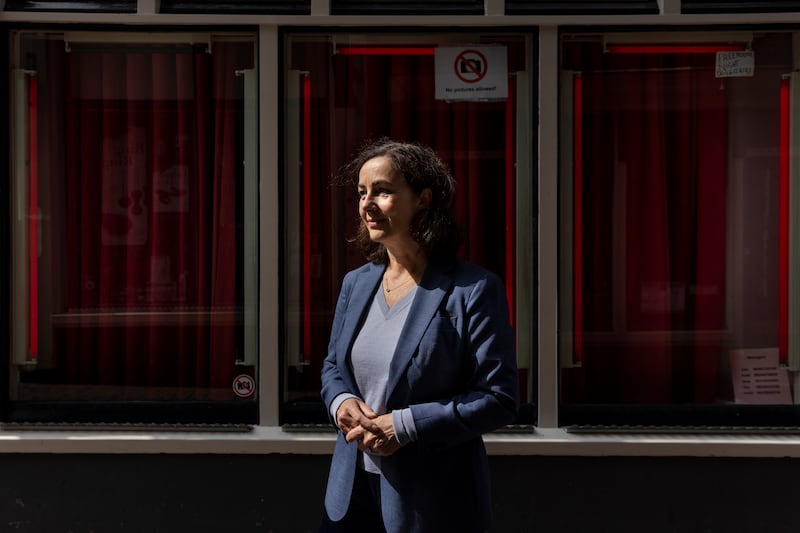It takes years of living in the Netherlands to realise that its legendary “anything goes” approach to sex and drugs is not so much about open-mindedness as a tried-and-tested stratagem to maintain social control and keep the illicit firmly where it belongs – in check.
For 400 years it worked. The red light district of De Wallen in the heart of Amsterdam was where the sailors of the Dutch East India Company returned for much-needed R & R from their voyages to the Far East at the spearhead of a new era of globalisation at the start of the 17th century.
Similar little streets, dotted with red lanterns, sprang up in towns all over the Netherlands. Globalisation was part and parcel of the sailors’ culture. With it came exotic drugs from exotic locations. If a criminal underbelly was to be the price of the Dutch Golden Age, nobody complained.
There was even a Dutch name for that criminal underbelly, the penoze, and by the 18th century the internationalised criminals of Amsterdam, Rotterdam and The Hague had developed their own secret language, bargoens, to lock out snooping authorities.
READ MORE
Nobody complained, that is, until the first years of this century when tourism was identified not alone as a good thing with the power to supercharge economies but potentially as a bad thing too with the power to destroy them – making previously desirable locations increasingly undesirable.
The official number of international tourist arrivals – right around the globe – doubled between 1998 and 2019 to 2.4 billion a year, according to figures from the World Bank. Welcome to the era of “overtourism”, a concept that made itself felt gradually at first and that encountered more than a little resistance from the vested interests of a travel industry that had become bloated from compulsive overfeeding.

Look for broadly comparable figures for Amsterdam and you’ll find that in 2010 it had 5.3 million visitors, which by 2019 had shot up to 9.2 million, not counting Airbnb users who probably accounted for a couple of million more.
What worried Amsterdam city council was that the narrative about the city had begun to deteriorate. In a world constantly in pursuit of clickbait, stories in a myriad print and online publications were much more likely to feature images of twenty-something stag parties wearing rubber penis-hats and throwing up on doorsteps than images displaying the world-class delights of the Rijksmuseum.
It began to skew the type of visitors coming to Amsterdam too. Well-heeled young people fancying “a moral holiday”, as one city councillor put it, poured into the winding streets of the canal belt and went a bit wild – while their more discerning parents began to stay away, heading instead perhaps for equally packed but less-juvenile Florence.
The late Labour mayor of the capital, Job Cohen, was the first to challenge the grip of organised crime on the city, beginning a clean-up in 2007 using the powers of the Bibob (Public Administration Probity Screening) Act, which allowed businesses to be closed by revoking their licences where there were “reasonably strong indications” of criminality.
An early high-profile target was the “upmarket” brothel, Yab Yum, located in a magnificent 17th-century canal house in the city centre, where many Amsterdam gangsters – most notoriously Klaas Bruinsma, alleged at one stage to have been a sailing friend of Mabel Wisse Smit, later to become Princess Mabel of Orange-Nassau – had had showdowns over the years.
Cohen was right: it was a clean-up whose time had come. However, such was the economic importance of tourism that the idea of a new future failed to gain real traction until more a decade later when the Covid pandemic showed cities all over the world how much more “liveable” they could become when the crowds were gone and those who lived there could step outside in peace.
That vision of a different future was an inspiration to the current mayor, Femke Halsema of the Groenlinks (Green-Left) party, who has committed herself to a radical overhaul the likes of which Amsterdam has never seen – and which, inevitably, is already facing opposition from vocal groups of sex workers and residents alike who say they’ll be worse off rather than better.

So what is the Halsema plan to revolutionise sex in this city?
Essentially the plan is to relocate most of the current red light district away from De Wallen to a 5,000sq m custom-built multistorey “erotic centre” in a less-congested area, built by a private developer on land provided by the city.
As ever the response from each of the three potential locations so far identified has been “not in my backyard” – though a final decision is expected in December.
In an interview with Time magazine recently, the mayor said she expected the erotic centre “to serve many different needs, including creating space for LGBTQI+ communities and offering cultural events linked to eroticism, such as lectures on feminism and tantric yoga courses”.
On the ground floor, she says, will be a mixture of sex shops, theatres, restaurants and bars. Rising above that in “two curvaceous and interlinked towers” will be at least 100 of the 249 “brothel windows” currently in the old city centre.
Social workers and medical assistance will be on-hand 24/7 lest there be any hint of unbridled enjoyment without a price, physical or mental, to be paid.
Halsema is philosophical about the objections and confident about the benefits. “Our aim is to change sex work by removing it from a setting that suggests any kind of criminality or shame. I don’t think we will ever meet everyone’s expectations. But we have to look at the bigger picture. And the question when we do is this: how do we make this city liveable for everyone.”
For better or for worse work is already under way. Council staff have already begun shuttering the sex workers’ windows that are to close permanently. Plans to close cafes and brothels at 3am rather than 6am at the weekends have already led to a protest march on city hall.
A ban on smoking cannabis in public places came into effect in May on pain of a €100 fine, and using laughing gas has been illegal since January 1st.
In response to a plan that’s supposed to make sex work safer and more transparent, many sex workers say they may have to start working illegally outside hours to make up for the income they’ll lose due to the new regulations. “Before midnight people just walk by and take a look but they don’t pay”, said one sex worker. “Halving our hours after midnight could halve our income. We need those three hours.”

Surveys over the years – most recently from Erasmus Medical Centre in Rotterdam – have consistently shown that legal prostitution is the safest form of sex work. Sex workers are more likely to encounter violence, and less likely to report it, when they work illegally.
Another points out that not all sex workers have the same types of clients and that therefore their responses to the erotic centre differ. “Some prefer the old red light district, some prefer to work at home, others might prefer the erotic centre. For instance trans and other LGBTQI+ sex workers often work in places without the same level of safety and visibility as the old De Wallen windows have. So for people from the LGBTQI+ community the erotic centre could be a good solution – but in addition, not as a replacement.”
And when the old red light district is reduced to a sanitised version a fraction of its current size what will happen to the 6,500sq m or so of prime real estate it used to occupy?
Just as the growth of the current red light monstrosity was a largely unregulated organic process, with brothels followed by cannabis cafes, drug paraphernalia shops, tacky souvenir outlets, bars and takeaways, so the same economic imperative will reverse that process as well, at least partially.
The city hopes to turn back time, to watch and encourage as hotels and shops revert to homes and offices in streets with just a small fraction of the footfalls that have become commonplace in recent decades, and without the pervasive aroma of multinational takeaways or the pungent waft of weed.
Is it possible that a decade from now breathless online news about the latest in penis-hats in Amsterdam will have been replaced by rave reviews of the latest Rembrandt, Vermeer or Van Gogh exhibitions? If so it will certainly be a changed place. But will it be a better place?
This is something that Gianni Cito, an architect with the firm Moke, who drew up the preliminary designs for the erotic centre, has been thinking about. “I came to Amsterdam in the 1990s and it was a really open-minded city”, he recalls. “All of a sudden it has become much more conservative than I thought. If there’s no space now for what the city has always had then perhaps it’s just not the same city.”




















